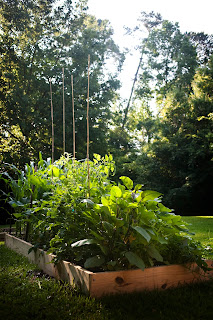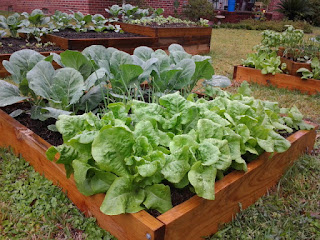If you're like me, you'd love be able to pick something from your garden, more or less, everyday - something to base dinner on or something to give it that extra touch of flavor and the health that only fresh can provide. Growing your groceries gives you the freshest food money can't buy as I like saying. Unfortunately there's a deep seated myth in the American psyche about having a food garden.
I can't count the number of folks I've met at workshops, calls and emails I've received, and Facebook comments I've gotten over the years from folks saying something akin to: "I'd love to have you out to help us start a garden once... we've got a bigger place" - or - "we move to the country." The assumption here is that in order to have a successful garden, it's necessary to replicate our grand & great-grandparents' multi-acre gardens. This just isn't the case - for two reasons, well, three.
You just don't need a lot of space to #GrowYourGroceries.
But how can that be?
For starters, unless you're a serious jump-in-the-deep-end type, you're not likely to swear off the grocery store entirely. That means you can still buy things like potatoes and onions- not to mention your grains- that are relatively cheap at the store (and take a lot of space and time in your garden). By focusing on growing the right veggies (such as those most perishable and most expensive), you'll save yourself at least a good 60-70% of the space compared to the subsistence gardens of times past. So, whatever that vision of the country garden estate you thought you needed, chop that in thirds.
Also, as it happens, much of what folks think they know about agriculture, actually comes from the cultural legacy of the puritans' experience, a la pumpkins in October, Thanksgiving in a time of bounty before winter sets in, etc. Need I point out that the puritans were in New England, a place, Google tells me, is 1200 miles, more or less, due north of us). Folks, we're in the Deep South. We have no need to grow an entire year's supply of food in a three month growing season because our reality is: we can grow 12 months a year, 4x as long. So, take what was left of your gi-normous garden from the previous step, and divide that in fourths.
Finally, because most of our gardening ancestors of yesteryear were first farmers, and when you've got a hammer, everything looks like a nail: they organized their garden crops in rows because farmers farmed with plows pulled by mules and, later, by tractors, and both required a giant row between crops for them to pass. Growing everything in well-spaced rows, is- from a space and a weed-prevention perspective (a story for another time)- a terrible idea. But land was (relatively) cheap, and farmers had plows, so "good straight rows" became synonymous with the perfect American garden.
Until sometime in the 70s, that is, when, along came a guy named Mel Bartholomew who asked a little question: If the seed packet says I can plant lettuce every 6" in the row, could I simply plant them that far apart between the rows, too? (Instead of 30" apart like the seed packet said). Turned out: it worked. He tried a 3rd row, then a 4th. How long could he keep this up growing rows next to rows? Turns out, if you have dedicated paths and beds not more than 4 feet across, you could reach to the center to plant, to thin, tend, weed, and to harvest without need to ever step into your garden beds at all - no rows required. (Mel ended up writing a book you might know: Square Foot Gardening.) Anyway, in the case of his lettuce, he could grow 8 rows of lettuce where before he could only grow 2. So, remember the remaining fragment of that giant garden you had planned originally? Cut it in half and then half again; you'll only need one of those four pieces.
If we do all that math, you'll need less than 1/45th that amount of space.
Or, in simpler terms, I recommend the equivalent of one 4'x8' raised bed for each adult eater in your household, a little more if you're a big veggie eater, a hair less if you really just want fresh herbs and salad on occasion.
It's counter-intuitive, I suppose, that a person who earns his living on building gardens would tell you to aim small, but in my experience right-sized (smallish) food gardens have proven over the years- personally and for my customers- to be the longest lasting, and most loved gardens - not to mention productive. This is probably because the work-to-reward ratio is just awesome. Let me give you two quick examples.
For starters, let's revisit my GrowCart. Right now I've got 20 different types of edibles growing in what is a glorified grocery cart. Granted, it's a bit over-planted to be fair, but it's bursting with abundance, and it's tiny in terms of gardens. Imagine how long it took to plant? How long it takes to water? No time flat.
And then there's my garden from a few years back when- for a time- my wife and I weighed and recorded everything we harvested. Our garden was 80 square feet, or two and a half 4x8 raised bed equivalents. We grew 400lbs in less than a year. That's over $1600 of the freshest produce money can't buy.
If you'd like to get a sense of what you could grow in a 4x8 raised bed food garden, find our free "What Can You Grow in a Square" pdf download on our resources page. It's our planting guide that includes a Square Foot Garden planting grid for you to plan your own garden.
- - -
If you're ready to grow your groceries...
Please, click here to see our services & book a consultation, so I can assess your site; we'll discuss design, answer your questions, talk #s, and get your project lined up. We offer turn-key raised bed food garden support services. Or, if you've already got a garden, but need a little seasonal support, click here.
Please, click here to see our services & book a consultation, so I can assess your site; we'll discuss design, answer your questions, talk #s, and get your project lined up. We offer turn-key raised bed food garden support services. Or, if you've already got a garden, but need a little seasonal support, click here.
If you'd like to support me...
in freely sharing my stories & expertise, please consider passing along this article to a friend or sharing on social media. Each of my articles take at least a couple hours of resource gathering, writing, and editing, so I want to make sure they don't just sit on the digital shelf.
- - -
904.240.9592
PS- If you don't already but would like to receive Man in Overalls' semi-monthly updates which contain stories and food gardening tips, click here to see former updates, and we'll add you to the list.


